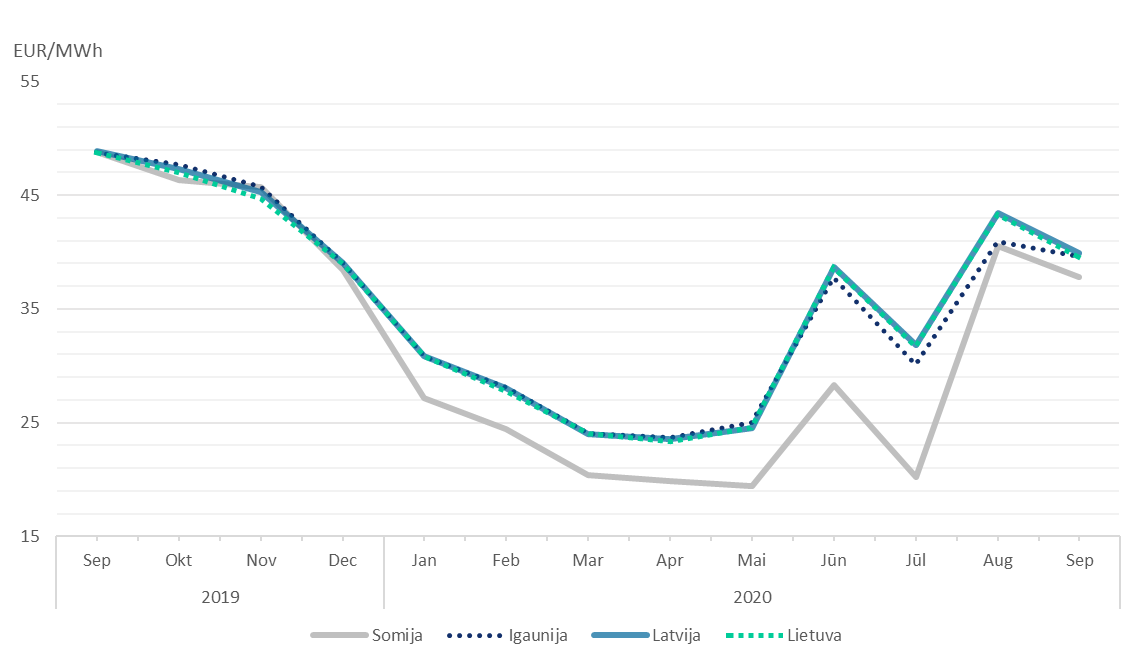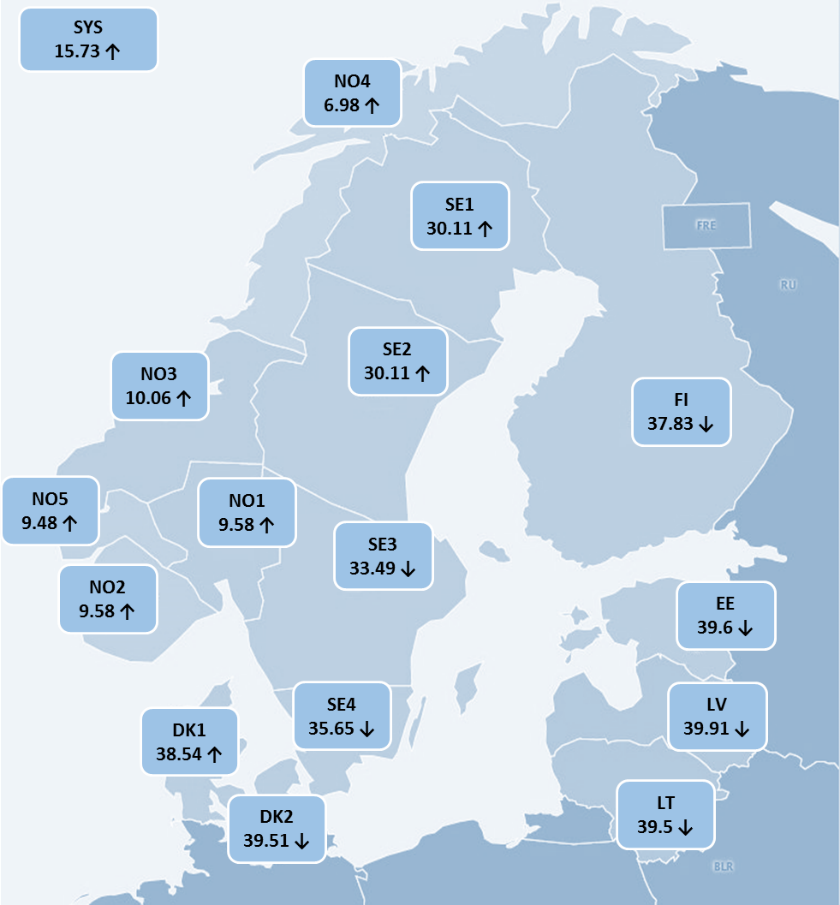In September, the average monthly electricity prices in the Baltics deviated from the high electricity prices in August, mainly due to lower electricity prices in neighboring countries.
–
Content will continue after the ad
Advertising
–
The previous month’s average electricity price in Estonia decreased by 3% to 39.60, while in the Lithuanian trade area the electricity price decreased by 9% to 39.50 EUR / MWh, but in Latvia the monthly average electricity price decreased by 8% to 39..91 EUR / MWh . In the Baltics, the hourly price range ranged from 1.46 EUR / MWh to 189.25 EUR / MW.
Wholesale electricity prices in Nord Pool sales areas

Source: Nord Pool
In September, the price of the electricity system increased from 8.79 EUR / MWh to 15.73 EUR / MWh, the low level was still affected by the Norwegian trade areas. Price differences between Nord Pool’s sales areas were affected by capacity flow restrictions and generation allocation. At the beginning of the month, higher electricity prices were affected by a decrease in reservoir filling, however, as weather conditions changed at the end of the month, higher precipitation resulted in an increase in filling levels and, consequently, hydropower in the Nordic countries. At the same time, the development of wind farms in the Nord Pool region also increased, amounting to almost 5 TWh or 15% more than in September of the previous year.
In the Baltics, electricity prices were affected by electricity prices in neighboring countries and higher energy flows – from Finland by 19%, Sweden’s SE4 region by 17%, as well as from the Kaliningrad region, but decreased from Belarus.
Wholesale electricity prices in September in Nord Pool retail areas

Source: Nord Pool
High volatility of electricity futures prices
In September, changes in the hydrological situation due to weather conditions affected the volatility of future electricity contract prices. At the beginning of the month, the hydrological balance was 11.5 TWh above normal, but at the end of the month it increased to 16.2 TWh due to weather forecasts of higher precipitation. In addition, price movements in the emissions trading market also affected price fluctuations in the Nordic futures market.
Electricity future contract (Nordic Futures) system prices increased by 22% to 19.57 EUR / MWh in October, the contract closing price decreased to 15.70 EUR / MWh. The average contract price of the system in the 4th quarter of 2020 increased by 13% to 23.29 EUR / MWh, the closing price of the contract decreased to 25.55 EUR / MWh at the end of the month. In September 2021, the average price of the futures system increased by 10% to 24.34 EUR / MWh, and at the end of the month the contract price was 24.00 EUR / MWh.
The average price of Latvian electricity “futures” for the October contract increased by 1% to 43.52 EUR / MWh, the closing price of the contract was 37.20 EUR / MWh. In September 2021, the price of Latvia’s “futures” in September, following market trends, increased by 14% to 44.28 EUR / MWh.
Electricity generation in the Baltics has decreased
Compared to September of the previous year, electricity consumption in the Baltics decreased by 1% to 2,109 GWh. In Latvia, it decreased by 1% to 556 GWh, compared to September 2019, in Estonia it decreased by 2% to 604 GWh, while in Lithuania it remained at the level of September of the previous year – 949 GWh.
In September, the amount of electricity generated in the Baltics decreased by 7% to 1247 GWh compared to the previous month. In Latvia, electricity generation decreased by 14%, producing an average of 333 GWh per month. In Estonia, too, production decreased by 12% compared to the previous month – 433 GWh. In Lithuania, on the other hand, electricity generation increased by 6% to 481 GWh.
In September, generation in the Baltics covered 59% of electricity consumption; In Latvia, the ratio of development to consumption was 60%, in Estonia 72%, and in Lithuania 51%.
Access to the Daugava at the level of the norm
In Latvia, the total precipitation was above the September level. The average monthly inflow into the Daugava was 250 m3/ s jeb par 50 m3/ s above the 30 – year average inflow level.
In September, slightly higher inflows resulted in electricity generation “Latvenergohydropower plants increased by 38% to 101 GWh compared to production in August. In turn, electricity generation at Latvenergo TEC decreased by 45% to 132 GWh compared to August, and the first TEC-2 power unit was not available on the market due to annual maintenance work.
Oil prices prices have risen in other commodity markets
The price of the Brent Crude Futures crude oil futures contract fell by 8% to USD 42.07 / bbl in September, and the contract closed at USD 41.03 / bbl at the end of the month.
Oil market prices continued to be affected by the continued nature of demand as a result of the Covid-19 pandemic, as well as fluctuations in global financial markets. In addition, higher oil inventories in the United States contributed to the downward trend in oil prices.
Coal future contract (API2 Coal Futures Front month) the average price in September increased by 6% to 53.70 USD / t, the closing price of the contract was 57.05 USD / t.
Prices in the coal market were affected by supply disruptions from Colombia and reduced coal mining in Russia. In August, 13% of total electricity generation in Europe was generated by coal-fired power plants, while in September production increased to 15%. Demand was affected by higher natural gas and allowance prices, in anticipation of seasonal increases in demand. However, future fluctuations in coal prices will be determined by weather and economic developments.
In September (Dutch TTF) The average price of the October natural gas contract increased by 22% to 11.33 EUR / MWh, and the contract ended at a higher price of 12.28 EUR / MWh.
In the natural gas market, price fluctuations were determined by higher demand. At the same time, disruptions in natural gas supplies from Norway have been observed, as well as the volatile nature of emission allowance prices. In Europe, the filling level of natural gas storage facilities at the end of the month was 94.7%, which is below the level of 2019 – 96.7%.
European emissions quota (USA Futures) The price of “EUA Dec.20” increased by 3% in September to 27.80 EUR / t, and the contract price at the end of the month was 26.93 EUR / t.
In September, the carbon market saw a higher level of market allocation. As a result of higher supply and fluctuating demand, the closing prices of the trading day during the month ranged from 26.17 EUR / t to 30.47 EUR / t. Such fluctuations were affected by both fluctuations in commodity markets and new outbreaks of Covid-19. In addition, the price direction was also determined European Commission statements on the new goals of the European Climate Act or Green Course to achieve climate neutrality by 2050.
–


